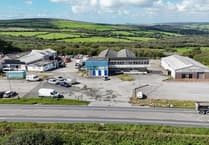For only the third time in the air station’s 77-year history, engineers and landscapers have begun replacing the perimeter fence around RNAS Culdrose.
It will take most of 2024 to pull down the existing structure and erect its successor – part of a wider major redevelopment and investment in the Cornish air station.
The air base covers a 1,540-acre site – split by the A3083, the main road to the Lizard, which separates the operational airfield from the administration and accommodation hub – demanding nine miles of fencing to keep unwanted intruders out.
Installing a third-generation barrier is not ‘simply’ a case of pulling down the old fence and putting up a new one.
The land around the fence line was cleared last year, including a number of mature trees near the main entrance which were near the end of their lives.
The work would inevitably damage their roots and make them unsafe.
“Our current perimeter fence is well past its best and has been in need of replacement for some time,” said Cpt Stuart Irwin, Culdrose’ commanding officer.
“Aside from the security implications of protecting Culdrose, the generally poor appearance of the fence has been an annoyance to our personnel and the wider community, who are proud of the Royal Navy and rightly want the air station in a ship-shape condition.”
And while nine miles of military fencing might not look particularly becoming in the Cornish countryside…there’s a major planting initiative going hand-in-hand with the new fence: 6,600 trees, shrubs and bushes.
Cpt Irwin added: “This project includes planting thousands of native trees and bushes to screen the base as much as possible, which is after all on the edge of an area of outstanding natural beauty.
“Most of the trees will go to the north of the airfield as well as around the living quarters to the south of main road.”





Comments
This article has no comments yet. Be the first to leave a comment.